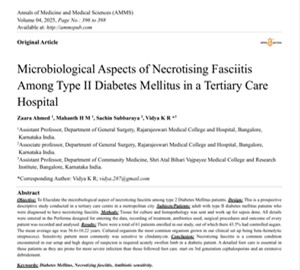Microbiological Aspects of Necrotising Fasciitis Among Type II Diabetes Mellitus in a Tertiary Care Hospital
Authors
##plugins.themes.bootstrap3.article.main##
Abstract
Objective: To Elucidate the microbiological aspect of necrotizing fasciitis among type 2 Diabetes Mellitus patients. Design: This is a prospective descriptive study conducted in a tertiary care centre in a metropolitan city. Subjects/Patients: adult with type II diabetes mellitus patients who were diagnosed to have necrotizing fasciitis. Methods: Tissue for culture and histopathology was sent and work up for sepsis done. All details were entered in the Performa designed for entering the data, recording of treatment, antibiotics used, surgical procedures and outcome of every patient was recorded and analysed. Results: There were a total of 61 patients enrolled in our study, out of which there 43.5% had controlled sugars. The mean average age was 56.6±10.22 years. Cultured organism the most common organism grown in our clinical set up being beta-hemolytic streptococci. Sensitivity pattern most commonly was sensitive to clindamycin. Conclusion: Necrotizing fasciitis is a common condition encountered in our setup and high degree of suspicion is required acutely swollen limb in a diabetic patient. A detailed foot care is essential in these patients as they are prone for more severe infection than those followed foot care. start on 3rd generation cephalosporins and an extensive debridement.
##plugins.themes.bootstrap3.article.details##
Copyright (c) 2025 Zaara Ahmed, Mahanth H M, Sachin Subbaraya, Vidya K R

This work is licensed under a Creative Commons Attribution 4.0 International License.
Creative Commons License All articles published in Annals of Medicine and Medical Sciences are licensed under a Creative Commons Attribution 4.0 International License.
[1] Elliot MD, Kufera JA, Myers RA. The microbiology of necrotizing soft tissue infections. Am J Surg. 2000; 179:361–366. DOI: 10.1016/s0002-9610(00)00360-3.
[2] Wong C-h, et al. Necrotizing Fasciitis: Clinical presentation, microbiology, and determinants of mortality. J Bone Joint Surg. 2003;85-88.
[3] Hsiao CT, Weng HH, Yuan YD, Chen CT, Chen IC. Predictors of mortality in patients with necrotizing fasciitis. Am J Emerg Med. 2008; 26:170–175. DOI: 10.1016/j.ajem.2007.04.023.
[4] Wall DB, Klein SR, Black S, Virgilio C. A simple model to help distinguish necrotizing fasciitis from nonnecrotizing soft tissue infection. J Am Coll Surg. 2000; 1913:227–231. DOI: 10.1016/s1072-7515(00)00318-5.
[5] Dahl PR, Perniciaro C, Holmkvist KA, O'Connor MI, Gibson LE. Fulminant group A streptococcal necrotizing fasciitis: clinical and pathologic findings in 7 patients. J Am Acad Dermatol. 2002; 474:489–492. DOI: 10.1067/mjd.2002.120536.
[6] Goh T, Goh LG, Ang CH, Wong CH. Early diagnosis of necrotizing fasciitis. Journal of British Surgery. 2014 Jan;101(1): e119-25.DOI: 10.1002/bjs.9371.
[7] Tan JH, Koh BT, Hong CC, Lim SH, Liang S, Chan GW, Wang W, Nather A. A comparison of necrotising fasciitis in diabetics and non-diabetics: a review of 127 patients. The bone & joint journal. 2016 Nov 1;98(11):1563-8. DOI: 10.1302/0301-620X.98B11.37526.
[8] Umbert IJ, Winkelmann RK, Oliver GF, Peters MS (1989) Necrotizing fasciitis: a clinical, microbiologic, and histopathologic study of 14 patients. J Am Acad Dermatol 20:774–781.
[9] Rea WJ, Wyrick WJ (1970) Necrotizing fasciitis. Ann Surg 172:957–964. DOI: 10.1016/s0190-9622(89)70089-x
[10] Kaiser RE, Cerra FB (1981) Progressive necrotizing surgical infections: a unified approach. J Trauma 21:349–355. DOI: 10.1097/00005373-198105000-00003

